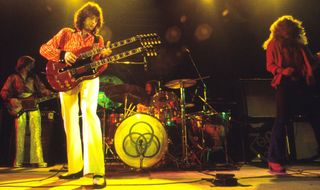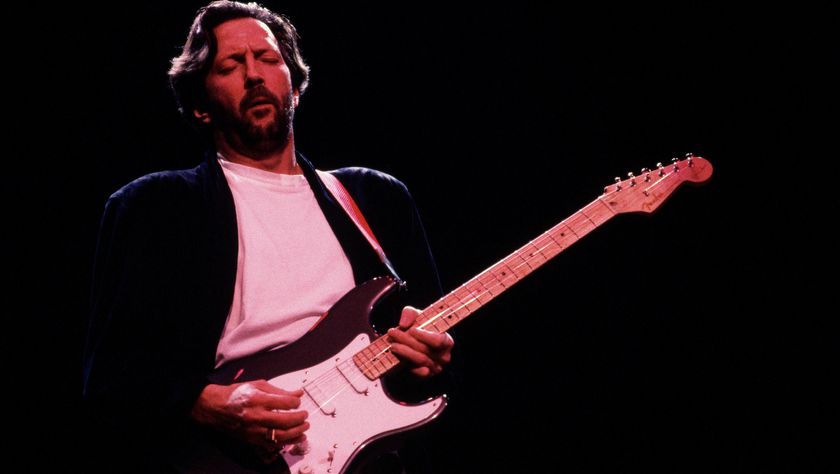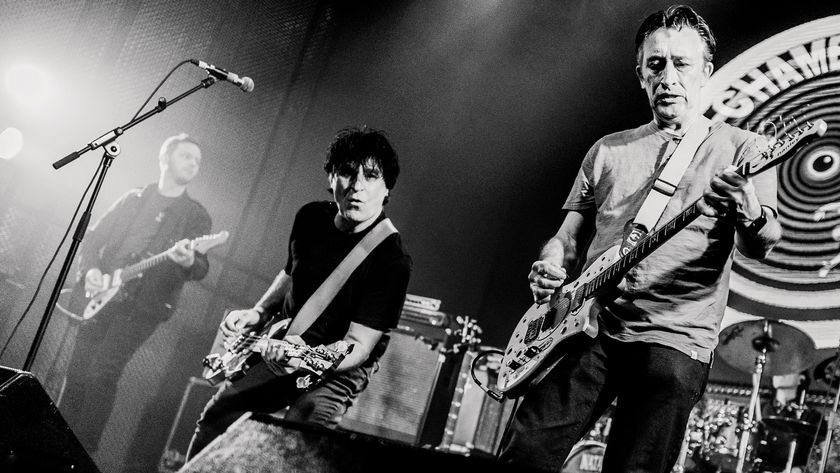Jimmy Page on how he pushed himself to the "outside edges" of harmony on Led Zeppelin IV and Houses of the Holy, and the other Stairway to Heaven 12-string
In this classic GW interview, Led Zeppelin's legendary guitar-slinger clears up a couple misconceptions about two of the band's landmark albums, while giving a rare inside look at his creative process

The following interview with Led Zeppelin's Jimmy Page was featured in the Holiday 2014 issue of Guitar World.
It’s a beautiful Indian Summer day, and I’m standing on Queen's Gate Road in London, England, a stone’s throw from the legendary Royal Albert Hall, where Led Zeppelin played in 1970, a performance immortalized on 2003’s Led Zeppelin DVD.
It’s a fitting landmark, considering that I’ve just finished a productive hour chatting with the band’s guitarist and producer, Jimmy Page, about the new deluxe editions of 1971’s Led Zeppelin IV (one of the best-selling albums in U.S. history) and its 1973 follow-up, Houses of the Holy.
I’m searching in vain for a taxi when, suddenly, a middle-aged man holding a sizable video camera on his shoulder walks up and politely introduces himself to me. In tentative English, he explains he’s with a Dutch television station that is producing a segment on the lasting importance of Zep’s classic Stairway to Heaven. At least, that’s what I think he says.
“So, vat is da meaning of dis song?” he asks.
Good question. I’ve written an entire book on Jimmy Page and have had a good three or four decades to think about it, so I should be able to say something relatively intelligent on the matter. But the truth is, it isn’t an easy task. There’s an elusive quality to the song that defies a simple explanation, which probably explains its extraordinary durability.
I surprise myself by speaking quite passionately about the song’s theme of spiritual yearning and redemption. I concede that the lyrics are pretty vague, filled with lines like “sometimes words have two meanings,” “there are two paths you can go by” and “there walks a lady we all know/who shines white light and wants to show/how everything still turns to gold.” But, like any other mystical text, the song’s virtue is in its ambiguity – it’s designed to draw you in and “make you wonder."
Get The Pick Newsletter
All the latest guitar news, interviews, lessons, reviews, deals and more, direct to your inbox!
I conclude by telling him that the enduring popularity of the entire Led Zeppelin IV album is probably due to the strange timelessness buried within its musical DNA. Songs like Battle of Evermore, When the Levee Breaks, Rock and Roll and Stairway are profound in their ability to shift between the pagan rituals of Stonehenge and some unspecified space age where “all is one and one is all.”
“It’s not an album – it’s a work of comparative mythology,” I sputter.
The Dutch cameraman smiles and seems satisfied, if not a little puzzled, by my response. After he leaves, I’m a little mad at myself for not bringing up these ideas to Page during our interview an hour earlier, but as a guitar journalist, I was on a different mission.
Last June, Led Zeppelin launched an ambitious campaign to reissue their catalog, releasing remastered versions of their first three albums, each accompanied by a second disc of entirely unreleased music related to that album. As the holidays approach, a second round begins with special editions of their fourth and fifth albums, IV and Houses of the Holy.

The Led Zeppelin IV deluxe edition includes unreleased versions of every song on the original album, including alternate mixes of Misty Mountain Hop and Four Sticks, stripped-down guitar/mandolin instrumental versions of Battle of Evermore and Going to California and the much-speculated-about original Sunset Sound Studios mix of Stairway to Heaven.
The Houses of the Holy companion disc offers rough and working mixes of The Ocean and Dancing Days as well as revealing guitar-heavy mixes of Over the Hills and Far Away and The Rain Song, and a cool alternate take of The Song Remains the Same.
It’s a ridiculous amount of ground to cover in 60 minutes, but Page seems game. Well… pretty game. As an interview, Jimmy is as dynamic and quirky as his music. He’s a highly original thinker who can dazzle with his clarity and insight, but when he wants, he can be as secretive and mysterious as King Solomon.
Just the mention of a song title will have him enthusiastically holding forth in great detail, while seemingly innocent questions about guitars or effects can be met with a succinct, “I’m not going to answer that.”
But, hey, it’s all cool. Just like Stairway to Heaven, a little bit of mystery always makes you wonder.
One of the biggest bits of news is that you’ve included some of the original Los Angeles mixes of IV on one of the bonus discs. The story has always been that, aside from When the Levee Breaks, the mixes done at Sunset Sound Studios were a disaster. However both Stairway to Heaven and Misty Mountain Hop, both included in the companion disc, sound pretty damn good.
"After we completed most of our work on the fourth album at Island Studios and Headley Grange [a remote three-story stone farmhouse that Zeppelin used as a recording facility], [engineer] Andy Johns and I went to Sunset Sound in Los Angeles to mix.
"The tapes included most of the music that would end up on IV, including Stairway, Going to California, and even a few things that ended up on Physical Graffiti, like Down By the Seaside and Boogie with Stu – but not Battle of Evermore, which wasn’t finished yet.
"We did some great work there, and I was particularly impressed with their wonderful echo and reverb facilities. The only problem was, they also had a rather 'colorful' studio monitoring system. While we were mixing, everything sounded huge and the low end sounded especially massive. But when we returned to England and played our work back, the sound was nothing like what we had heard in Los Angeles. It was deflated… a pale echo of what we’d heard in L.A.
"Around that period of time, there were alarming stories of tapes that had been damaged or slightly erased or interfered with by magnets used by airport security. We all wondered whether anything had happened to them. In actual fact, nothing had happened to them. Regardless, the band was not particularly enamored with the way things sounded, so I agreed to remix everything.
"There were exceptions. The Sunset Sound mix of When the Levee Breaks had a density that we could not be replicated when we remixed it in England. It didn’t have that space – that black hole. So we put that one on the original album. We’ve included the remix on the companion disc so you can decide for yourself."

You also included the Sunset mix of Stairway, which also sounds pretty good.
"Yeah, it’s also pretty superb."
When you were putting together the companion disc, did you have any second thoughts? Did you think any of the alternatives would’ve been better to put on the original albums?
"Well... I don’t know about that. I think it is what it is. I suppose you could look at it this way: you wouldn’t have the versions that you know, and you wouldn’t have had the possibility to use these wonderful versions for the bonus disc! [laughs] It might’ve [taken] 30 or 40 years to manifest, but Zeppelin runs on sidereal time – or time you can stretch – within the music and in the general ambience of the band."
On the original version of Rock and Roll, the beginning of the solo is almost buried, and then slowly emerges as it unfolds. On the companion disc, the alternative mix offers more clarity, but it begs the question: why did you bury it in the first place?
"It makes you listen harder! I didn’t want it to be vulgar and punch the listener in the nose, I wanted to play with them a little bit and draw them in. It’s actually pretty interesting what’s being played."
The new version of Four Sticks also offers more clarity in certain areas, particularly in John Bonham’s drums. There is so much going on in that song. Was it difficult to achieve a final mix?
"There were a number of attempts to get that song right. I know, because I just reviewed them all! You’d get to the point where you could hear all the textures… and then realize there wasn’t enough bass. [laughs] Back in those days, it was all manual mixing, so every mix is different, which is really rather good. Getting a great mix was a kind of performance itself. We didn’t start having automated mixes until In Through the Out Door.
"I suppose you could argue which one is better, but on both versions of Four Sticks – the original and the alternate version – you really get the feel of the ride of the mix and how we’re trying to get all the textures to organically move throughout the song. I’ve always felt that Four Sticks was very abstract, so it was particularly important to get the soundscape right. In some ways, the textures are the song.
"But regarding hearing John’s performance, or some of the other nuances, I was very diligent during this whole process to release things that had real musical value. A lot of thought went into what we were going to use to compliment the original tracks."
Going back over both of these albums, it’s striking how much electric 12-string guitar you used. What was the primary guitar?
"Well, on Stairway I used both my Vox Phantom that I used on Thank You and my Fender Electric XII."
Did you use them for tonal differences?
"Not really. They both sort of sounded the same. It was more about how they played. They felt different. On Song Remains the Same, it’s just the Fender."
Listening to the dramatic, stripped-down version of Battle of Evermore on the companion disc, something occurred to me. What came first, the mandolin or the guitar part?
"The mandolin part. I was at Headley Grange one evening and started playing John Paul Jones’ mandolin. I had never really played a violin or a ukulele or any instruments with those kinds of tunings, but before I knew it I had written the whole thing – the verses, the chorus and the breakdown.
"The rhythm guitar was created later because I had to work out what the chords were and the correct inversions – because I didn’t know what chords I was playing on the mandolin."
Why fade the track halfway through?
"It’s a vignette. It’s similar to how I handled The Song Remains the Same on the companion disc. I wanted to give the listener a sense of how the track evolved, but didn’t feel the need to belabor the point. Same with Going to California – that’s not the full-length version, either. It’s about illustrating the texture and vibe."

I think you’ve said each album is essentially a reflection of what you were feeling at that particular time and space. Houses of the Holy is the most celebratory album in your catalog. It’s the only album without a blues.
"Well, I’m not sure I’ve ever said it was a summing up of where we were at that point in time; it’s more about what we’re managing to achieve musically under the roof of a recording facility. I think it’s more about how we’ve managed to push things, and we’d been pushing all the way through.
"Here’s the interesting thing – if we had been forced by the record company to make singles, we would’ve never been able to explore like we did or make albums like IV or Houses of the Holy. Because we created each album as an independent production, we could actually dictate that there would be no singles. And when you look at the whole of the catalog, my god, you realize what a saving grace that was not to have to comply with commercial radio.
"Our attitude was, 'Here’s the album, and if you want to give something to radio, then fair enough, but don’t bother asking us to follow it up with something similar.'"
Houses features some of your most layered and complex guitar arrangements. Around this time you had installed a home multitrack studio. Did that influence the material on Houses?
"Yes, I did have a home multitrack recorder, and I was experimenting quite a bit, and certainly some of it was done with Zeppelin in mind. The Rain Song was one of the tracks that I had developed at home. My demo features a Mellotron and everything – I didn’t play it as well as John Paul Jones, of course – but the whole idea, with all the various movements, was done at home."
What about Over the Hills and Far Away?
"No, because that was easy to convey to the band with just a guitar. What I wanted to achieve with The Rain Song I felt was less evident from just performing the guitar part, so creating a demo was important.
"To be honest, I just usually taped things to remind myself. One of the most important things to remember is that musicians of our generation – before there were cassette recorders – had to remember everything. Most of the time I didn’t really need to record demos because I had already committed the idea to memory."
The Song Remains The Same is genuinely unusual. It’s almost a compendium of folk and country guitar techniques presented in a completely different context – the opening solo features straight flat-picking, the bends behind the vocals are reminiscent of country guitarist Clarence White, and there’s a healthy amount of hybrid picking on your Fender XII.
"That’s fair enough. It wasn’t intentionally any one of those things. It was just the result of me listening to all these alternative six-string things at the time and summing them up… or perhaps reprogramming them. [laughs] But it’s all a question of taste – of what you put in or leave out to make the most of your technique relative to the song.
"I was so OCD then that, by the time it came for me to record my guitar parts, I was completely absorbed by what I was doing and the right parts just seem to come out. And most of the solos were pretty spontaneous. I’d warm up and then immediately record, and then I’d do the next one. I never wanted to labor the point of anything."
Continuing with the uplifting theme of Houses, I’d like to talk about Dancing Days.
"Yes, that whole song is like a celebration – it’s jubilant. But I would say Houses of the Holy is an album of many moods. Each song captures an essence of a feeling, an emotion or sensitivity, and you can hear the band maturing as we play all these different styles. I feel there’s a logical progress from each album. You can see the expansion and risks we were taking. Or should I say, the new territory that is there to be civilized and conquered. [laughs]
"Dancing Days is interesting because I remember exactly where I was when I laid down those slide guitar parts. I was at Olympic in Studio One, and I stationed myself in the control room and fed my lead out to an amp in the studio. I wanted it really loud, and you could get the ambience of the whole room. I just roared. I hadn’t even worked out what the part was going to be. But I guess I was so on top of my playing that I could just sort of do that.
"It sounds like the arrangement to that song was all sort of meticulously worked out, but it all just came out, and all I had to do was a few little drop-ins and the song was done. And then I double-tracked it as well. It was pretty spontaneous. When the rest of the band came in later, I said, 'I hope you’re gonna like this.' They were like, 'Wow!'"

Houses of the Holy sounds different than any of your other albums. Your guitar sounds brighter, and the drums are a more refined version of the groundbreaking sound you created on IV.
"I thought it was important to make each Led Zeppelin album sound radically different than the one before. All the changes were intentional. That’s why we used different engineers and different locations.
"I don’t want to go into detail, but I used a lot of different guitars on Houses, which might account for some of what you are hearing. And although we used some of the same techniques to record John’s drums that we developed at Headley on IV, most of Houses was done in a traditional studio, which is why it sounds brighter. You wouldn’t have the same expansion and headroom that we had with the high ceilings in Headley."
Why isn’t the song Houses of the Holy on Houses of the Holy?
"Because it comes out on the next album. [laughs] It’s meant to be a little mischievous."
This hiss is quite audible on the version of No Quarter on the companion disc. Did you hesitate to use it, or did you try to eliminate it using modern technology?
"It was such a great take by John Paul Jones, I wasn’t about to let a little hiss stop me from using it. In some ways, it adds to the ambience of the time and place."
The guitar solo on the original version of No Quarter is one of your more unusual statements. It’s jazzy without being jazz.
"With the piano being the way it is, the last thing I wanted to do was play a jazz homage. It would’ve been too obvious. I wanted to show the guitarist hasn’t gone to sleep – he’s thinking about presenting the composition in a different way, using different colors and tones and figures that are… spritely. It’s like water nymphs or something coming through."
While the music on Houses is primarily upbeat, your use of dissonance on the opening riff of Dancing Days, and the rather sour use of seven chords on sections of The Ocean, undercuts the happy subject matter and keeps them from sounding too... cozy.
"I never really wanted to take the easy way out. Those harmonies you are talking about are stretching and pushing those songs and making them a bit angular. You’re not in a comfort zone when you are listening to the opening riff of Dancing Days, but I think it feels natural in a dark way.
"It’s Dancing Days, but it’s not disco! It’s not the norm. It’s not a chug-along thing. It’s got intent in its attitude. It’s an attack. Although it’s not as extreme, that idea also appears on the solo to Misty Mountain Hop. I was pushing myself to explore new areas of harmony. I wanted to investigate those outside edges – maybe push myself over the edge! I’m surprised, really, that I’m here to tell the tale."
A long time ago in a galaxy far, far away Brad was the editor of Guitar World from 1990 to 2015. Since his departure he has authored Eruption: Conversations with Eddie Van Halen, Light & Shade: Conversations with Jimmy Page and Play it Loud: An Epic History of the Style, Sound & Revolution of the Electric Guitar, which was the inspiration for the Play It Loud exhibition at the Metropolitan Museum of Art in New York City in 2019.

“Zal is really nobody’s guitar hero. Fans say he’s the most underrated player ever; many guitarists rate him amongst the best... but I’ve never heard anyone call him their ‘guitar hero’”: Billy Rankin on lessons learned from the legendary Zal Cleminson

“It’s a whole new generation in sound. There’s nothing lacking”: Alex Lifeson reveals the gear that has finally converted him to digital modeling









